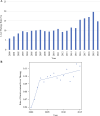Estimating the Survival Impact of Curative-Intent Liver Therapies for Colorectal Cancer Liver Metastases
- PMID: 40402423
- PMCID: PMC12317857
- DOI: 10.1245/s10434-025-17486-4
Estimating the Survival Impact of Curative-Intent Liver Therapies for Colorectal Cancer Liver Metastases
Abstract
Background: For patients with colorectal cancer liver metastasis (CRCLM), curative-intent liver therapies are associated with improved survival. However, randomized data are lacking, and individual-level retrospective data are limited by selection bias. We aimed to quantify the survival impact of these therapies by analyzing how regional variation in liver therapy rates influence survival outcomes within health service areas (HSA).
Patients and methods: The Surveillance, Epidemiology, and End Results (SEER)-Medicare database (2000-2020) was analyzed for patients aged 66-85 years with liver-isolated CRCLM who underwent curative-intent liver therapy (i.e., hepatectomy, ablation, or transplantation). Rates of resection within HSAs for each year were calculated. A comparison of observed versus expected survival was performed between two eras (era 1: 2002-2004; era 2: 2013-2015) to quantify the impact of changing rates of curative-intent liver therapy on HSA-level survival.
Results: A total of 34,781 patients across 163 HSAs were included. Most patients had synchronous CRCLM (65.8%) and received chemotherapy (63.1%); a minority (10.9%) underwent curative-intent liver therapy (hepatectomy, 74.3%; ablation alone, 24.9%; transplantation 0.8%). A total of 56 (34%) HSAs had the rate of curative-intent liver therapy increase (≥ 5%) across eras, 58 (36%) HSAs had the rate remain constant, and 49 (30%) HSAs experienced a rate decrease (≥ 5%). Each 5% increase in the rate of curative-intent liver therapy was associated with a 1.2% (95% CI 0.4-2.0%) increase in the risk-adjusted survival rate (p = 0.003).
Conclusions: HSA variation in rates of curative-intent therapy for CRCLM was associated with population-level changes in survival. These data quantify the expected improvements associated with efforts to increase patient access to curative-intent therapies for CRCLM.
Keywords: Cancer; Colorectal; Difference-in-differences; Liver; Medicare; Metastases; SEER; Survival.
© 2025. The Author(s).
Figures


References
-
- World Health Organization. Colorectal cancer; 2023.
-
- Force USPST, Davidson KW, Barry MJ, et al. Screening for colorectal cancer: US preventive services task force recommendation statement. JAMA. 2021;325(19):1965–77. - PubMed
-
- National Cancer Institute. Colorectal Cancer Screening | Cancer Trends Progress Report; 2024.
-
- O’Reilly DA, Poston GJ. Colorectal liver metastases: current and future perspectives. Future Oncol. 2006;2(4):525–31. - PubMed
MeSH terms
Grants and funding
LinkOut - more resources
Full Text Sources
Medical

